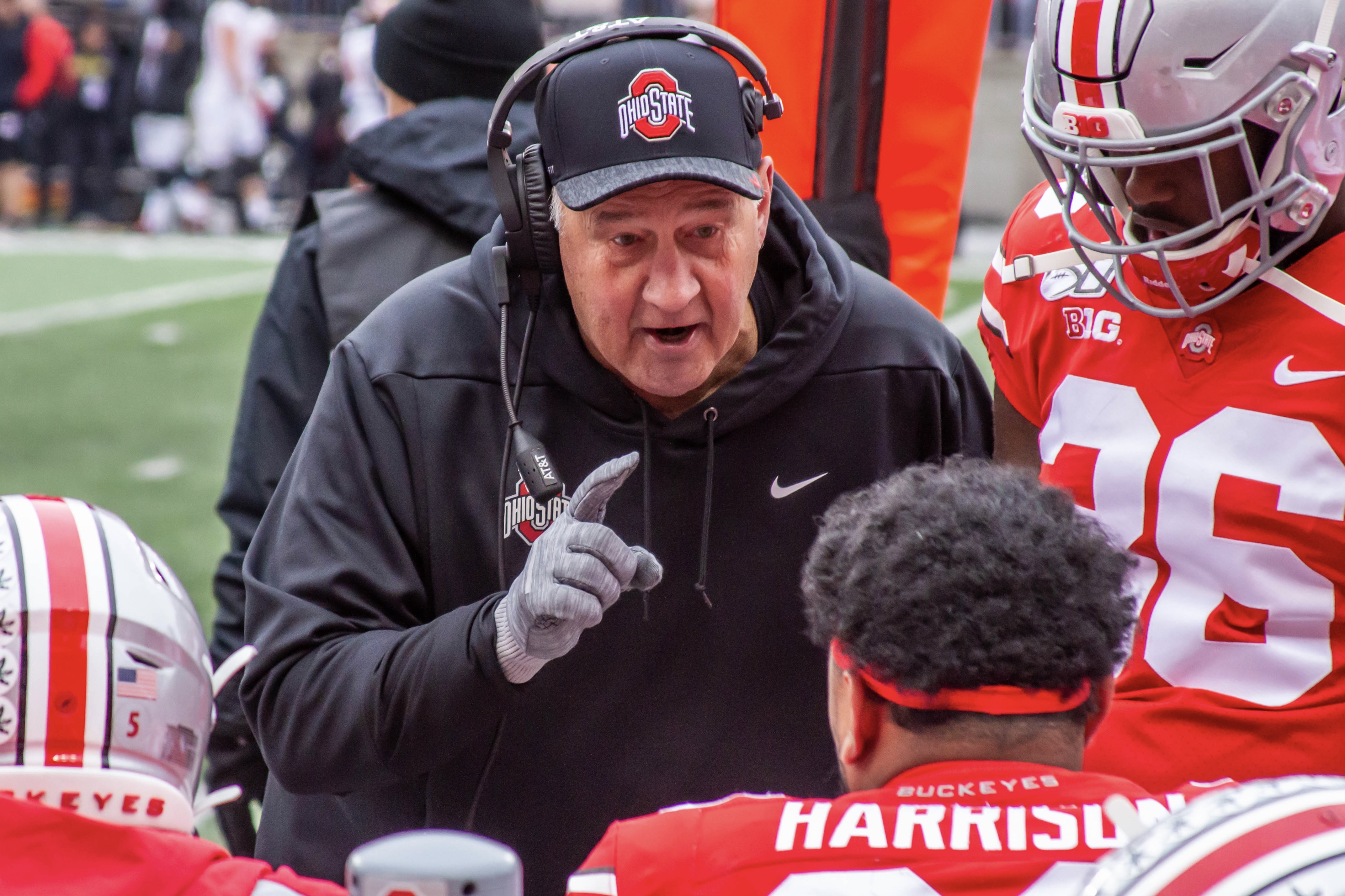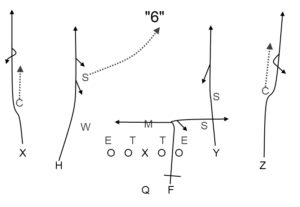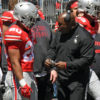
It’s a challenge to find true weaknesses in Clemson’s offense. The scheme is sound, directed by concepts that worked in 2015 when the Tigers first came into the college football limelight and continue to work four years later. The players, led by quarterback Trevor Lawrence, are excellent across the board, with very few positions that feel under powered or misfitting.
The stats of the offense support that. The Tigers have a top five offense in points per game (46.5, good for fourth), top 10 in rushing (252.9 yards per game, good for 10th) and top 20 passing attack (294.8 yards per game, good for 20th), all while allowing the sixth fewest sacks of any team in the country, with just 13. Even the advanced stats like Clemson, with the Tiger offense ranking sixth in Bill Connelly’s SP+ rankings.
Lawrence has elite receivers to throw to, an elite running back to hand off to, and a dominant offensive line. Regardless of opponent, or of early season struggles, this is one of the best and most balanced offenses in the country.
The key word there is balance. Ohio State has killed defenses all year with its balance, relying on the running attack to slowly wear opponents down while Justin Fields picks them apart in the passing game. There can be elite offenses without balance (see: Washington State), but when a team can move the ball in a variety of ways, it makes the job of the defense that much harder.
For Ohio State on Dec. 28 in the Fiesta Bowl, the job of the defense will not be stopping Clemson’s offense, because stopping this offense is not a reasonable goal. Since a close call with North Carolina on Sept. 28, Clemson has rolled every team it has played, and that group included some pretty decent defenses, like South Carolina’s and Virginia’s. This isn’t an offense that can be shut down, because there are too many weapons, and those weapons execute too well to be stopped for 60 minutes.
The goal, instead, has to be slowing Clemson down enough that the Buckeye offense can gain an advantage, hold onto the football, and grind out a victory on the ground. An easy way to think about the ideal gameplan for Ohio State here is to remember the 2014 Sugar Bowl. Alabama had a high-powered offense that gashed Ohio State to the tune of 35 points, despite a defensive performance that was, in large part, outstanding.
The Buckeyes were able to win, however, because they held onto the ball. With the threat of a downfield pass serving as a force to keep Alabama from closing in, Ohio State rode Ezekiel Elliott to big gains, tiring out the Crimson Tide defense late in the game. The talent disparity between Ohio State and Clemson is nowhere near what it was in that game, but Clemson’s offense is still one that needs to be worked around, regardless of how good Ohio State’s defense may be.
To break down how that may actually look for the Buckeyes, Clemson’s offense should be separated into two pieces: the passing attack and the rushing attack. Obviously, in a game, these two are inseparable, because they’re used in tandem. In a film study, however, it’s important to understand what a team is actually doing before understanding how they’re used together.
THE PASSING GAME
Clemson is not quiet about its intentions in the passing game. The Tigers want to cash in on big plays, create one-on-one matchups for elite receivers, and value explosive plays over efficient ones. Lawrence is one of the best deep ball passers in college football, and both outside receivers can turn 50/50 balls into 70/30 balls with their athletic ability.
Schematically, quite a but of the huge plays that Clemson has made a killing off of for years come from a brilliant Hal Mumme/Mike Leach invention that, when used correctly, can destroy even the best defenses: four verts.
Four verts has been bastardized since its inception, written off as too extreme in some circles and just plain silly in others. There’s a bias against it as a backyard football play above else that still permeates throughout most discussion about it among football fans. It’s easy to understand the bias, because four verts does, frankly, look like something that would be drawn up in a playground more than it does a professionally designed play.

Via Smart Football
This bias has faded in recent years with the success of coaches like Lincoln Riley, and the blurring of the lines between “spread” offense and air raid offense, but it still exists. Four verts, however, is in no way a gimmick, or something that is not planted firmly in a brilliant understanding of the offensive game. Four verts was, for a long time, completely unstoppable, largely because of its simplicity. Via Chris B. Brown of Smart Football:
“While each receiver was given a landmark they had to get to in order to stretch the appropriately stretch the defense, they were given lots of freedom to settle down their route or even break it off if they found open space along the way. So while the play was known as four verticals, the instruction was really, “Stay in your vertical lane, but then get open.””
To put that in even simpler terms, receivers are essentially given the control in four verts. They’re allowed to read cornerbacks, read blitz, read coverage and make a decision about how aggressively they’ll run their route, and where exactly that route is going. It makes thing much easier on receivers, and gives quarterbacks an easy read, as all they have to look out for is coverage, and the receiver that turns his helmet first.
Clemson can’t be considered an air raid team because at its core, Clemson is still running essentially the same thing that every non-Georgia team at the top of college football is running, which is essentially an amalgamation of Leach’s Air Raid, Urban Meyer’s power run, and Rich Rodriguez’s run-pass options. Clemson’s leans more towards the two formers than the latter, but it’s still a fairly common offense at its core.
It does, however, pull the four verts right from Leach’s playbook, and uses it brilliantly with those tall receivers.
Now, Clemson has added a play action tag here to keep the linebackers interested in the backfield, but this is a very similar concept to four verts, operating under the same basic idea of what will make it work. With an extra tight end in to help block against a six man front, Clemson uses a second tight end and Etienne to draw those linebackers in further, and in hopes that it may have safeties in man coverage (no such luck here).
Over the top, Higgins is running a go route that slants to the inside third, and Ross is running a modified go route that functions as more of a post, because he’s looking to undercut the deep safety and force the cornerback in man coverage onto his back hip, away from the ball to use his body as a shield. He doesn’t need that shield here, because he’s faster than the corner. With both safeties held in place by the distractions underneath, Ross is wide open and just has to make a play after the catch.
Aside from four verts, which Clemson will use frequently against Ohio State, the Tigers love to create one-on-ones with a pretty underutilized little trick that, again, fits perfectly with these big receivers. Clemson loves to throw away from trips.
This is a good example of what that actually means. Clemson comes out with two wide, an offset tight end, a halfback and then Higgins alone on the weak side of the field. The preplay read for the defense is either a counter run (more on that later) or, more naturally, something to this trips receivers, possibly four verts or a flood concept.
Instead, Clemson subverts expectations and goes to Higgins, who is left wide open because the cornerback is left alone for the rest of the defense to combat the loaded strong side. He’s afraid to be beaten deep with no help over the top, so Higgins is able to find soft space underneath quickly, and Lawrence just has to hit an easy out route.
This is a similar idea, with two tight ends in to help block and a play action tag to keep the safety busy, again pulling away help over the top and forcing that cornerback on an island to play conservatively. The attention goes to the halfback because of the two tight end set, and Higgins is again able to create space and pick up good yardage.
This is primarily how Clemson’s passing offense functions. It looks to draw attention away from its top receivers, and then exploit mismatches on the boundaries. The big play threat is always there, and the offense is designed to bust zones and beat up on lesser cornerbacks.
What the offense isn’t, however, is an RPO attack based on going after linebackers. The linebackers will be picked on in different ways, but outside of the redzone, Clemson really doesn’t care much about the middle of the field within about 10 yards. Behind that, it will look to attack behind linebackers and under safeties, but there really isn’t a ton of slant or drag based attack in this offense.
THE RUSHING GAME
Instead, Clemson’s attack at the short middle of the defense comes from the rushing attack. Like the passing attack, Clemson’s rushing attack takes much of its strength from misdirection, operating under the correct assumption that most college defenders aren’t disciplined enough to trust their assignments over their eyes.
To do that, Clemson deploys a counter heavy rushing attack not dissimilar from Wisconsin’s, which happens to have gashed Ohio State’s defense just a few weeks ago in the Big Ten Championship game.
Much of Clemson’s counter attack is actually deployed preplay, based on alignment. Offensive coordinator Jeff Scott loves to bait linebackers into making assumptions about the play call based on tight ends, running back positioning and what they would expect to see from a typical formation.
This touchdown against Virginia is a great example. Clemson comes out in 12 personnel (one halfback, two tight ends), with one tight end on the line on the short side of the field, the other offset on the long side, while the halfback is offset on Lawrence’s long side hip. The line may be balanced (no extra blockers on either side), but physically, a run into that short side of the field would make sense. It would have the back running downfield off a handoff, making for an easier handoff, while the offset tight end could serve as either a pulling lead blocker or a sealing blocker, with a pulling guard.
The linebackers make the same assumption. Watch the middle linebacker overreact in real time, reading a wash down from the line and assuming that Clemson is running inside zone. He looks to beat Etienne to the gap, and moves himself out of his own assignment, in between the end and the tackle. His job here is to trust that the blitzing nickel back can handle a Lawrence keep, and that the other linebacker can manage anything to the outside, while staying in the middle and preventing any sort of cut back by the halfback to get outside of that left tackle or tight end.
He doesn’t do his job, because he wants to make a big play. Because he’s slightly out of position, the left guard is able to get downfield and seal him off, while the tight end and left tackle seal the edge to create a lane off of Etienne’s counter. By the time Etienne reaches the line of scrimmage, Clemson has taken seven players out of the play, with and eighth out of the picture defending a receiver away from the play. The blitzing corner misses a tackle, and just like that, Clemson has used misdirection and overpursuit to create a touchdown against a seven man box and a blitzing corner.
Clemson forces linebackers to make assumptions during plays too. Here, the line is again blocking down, looking to spring Etienne off of the D gap, with the slot receiver sealing off a box safety to create a lane. The down block is the first hint for linebackers to bite down, but the real kicker here is Lawrence. Watch his eyes. He’s watching those linebackers, tricking them into thinking that he’s reading them, with the option being a keep or a handoff to an inside zone run for Etienne. Because there are defenders on the outside, the linebackers feel comfortable biting down to defend the handoff.
Except, the handoff doesn’t go there. Clemson runs counter again, and there are no linebackers to stop it, because they all got caught up in the mess of the middle of the field. Even No. 29, a safety, falls for it, and walks directly into a block. Just like last time, this is an example of defenders doing too much, and getting caught.
The Tigers don’t just pick on linebackers, though they may against Ohio State, because the defensive line cannot be fooled in the same way Ohio State’s linebackers can be.
With a down block to the right, North Carolina’s defensive line bites hard, especially the defensive tackles, who likely have no interest in watching this play ever again. With three linemen taken out of the picture by just the center and left guard, Clemson gives itself a nice edge, with the tight end, two pullers, and a loose left tackle responsible for two linebackers, an edge player and a blitzing cornerback that got caught behind the play. The tight end and right guard take care of the edge with ease, and the two linebackers fall right into blocks, creating the lane that Etienne needs. He doesn’t have to counter here, because the misdirection is done for him.
This is a large part of Clemson’s rushing attack. There is still some vanilla stuff, base inside zone, things that should be familiar to Ohio State, but most of Etienne’s big runs come on counter.
THE GAMEPLAN
All of this looks very bad for Ohio State, understandably. Clemson has an elite offense, a smart offense and a talented offense. This is big boy football, in a way that Ohio State hasn’t truly seen since the last time it was in the playoff, because Clemson is one of about five teams that has the talent and coaching to operate on this level. Ohio State has to come out with an excellent gameplan, the correct personnel and a confidence in what it is doing defensively that some players didn’t seem to have against Wisconsin or Michigan in the first half of either game.
Starting with the personnel, this should be mainly a 4-2-5 game for Ohio State. Clemson’s receivers are too good to cover with a zone, which means the manpower has to be out there to defend three elite receivers on every play. That doesn’t happen with three linebackers on the field, and without a real threat of RPO, there’s just no need to have seven guys in the box on every down.
In that 4-2-5, there are a few player options, but best 11 seems like the choice to match Clemson. In this case, that likely means a backfield with Damon Arnette, Jordan Fuller, Jeff Okudah, Josh Proctor and Shaun Wade. Proctor has been on fire recently, and those three corners will need to be at their best all game long, because they’ll be in a lot of man coverage. The two safety look will be explained shortly, because it’s a fairly new one for Ohio State this season. At linebacker, Malik Harrison is a must play, and the other spot should probably be either Baron Browning or Justin Hilliard, depending on how aggressive Jeff Hafley and Greg Mattison want to be.
Now, that does mean taking starters Tuf Borland and Pete Werner off the field on the base look. Ohio State hasn’t liked doing that this season. However, Borland’s tendency to overreact to preplay reads makes him completely unplayable against Clemson’s counter attack, and he’s no asset in the boundaries, meaning that he really doesn’t contribute much to this game. Werner could serve as a very good edge setter when Clemson comes out in that 12 personnel, but he really isn’t needed for much else, and is fairly weak in space and in reading offenses during the play. Browning overpursues at times too, but he at least has the athletic ability to recover.
Up front, there are no changes: Chase Young, DaVon Hamilton, Jashon Cornell and Tyreke Smith/Zach Harrison. This group is proven to be good, and can be trusted against this offense to stay strong and play smart.
Now, onto the two safety look. Ohio State deployed a little bit of two-high safety stuff against Wisconsin, though usually just dropped one safety into an underneath zone in cover 3, using him the same way that Wade is usually used. With Wade healthy, that won’t really be necessary. What is necessary, however, is help over the top. The three corners, while very good, cannot work alone, and will need help keeping Clemson’s receivers in front of them.
There’s no way to truly stop Clemson’s passing attack, and selling out to stop the deep ball will allow for the quick hits underneath. However, with two high safeties, or a man under 2 look, Ohio State can prevent those big plays in the passing game, and force Clemson to grind out yardage underneath. The Tigers will have room short if they want it, but Ohio State cannot afford to be giving up drives that end in just a few plays because of big gains.
With the back five focused primarily on coverage, the front six can spend much of its time on the rushing attack where, above all else, they just need to do their jobs and stay in position. If the front six is gap sound, Clemson’s big rushing gains can be taken out of the equation. Just like the passing game, short gains will happen, and if Clemson wants it, long, sustained drives will be available, but stopping big plays is more crucial than keeping Clemson from driving. The more time Clemson spends on the field, the more time for Lawrence or an offensive lineman to make a mistake.
This is essentially what North Carolina did back in September, with one key addition that ties all of this together: the blitz. North Carolina sold out to stop big plays, and for the most part, it worked. The cornerbacks were good, had help down the field, and were really only gashed a few times. Up front, the Tar Heels looked to create havoc, and play gap sound football to prevent big runs. It worked brilliantly, and with Ohio State’s talent, it’s a better option than anything else.
Take this play, for example. North Carolina’s linebackers are gap sound, no one overpursues, and the linebacker is able to make a play because he played smart, and did his job. Ohio State can absolutely do this against Clemson’s running attack, it just needs smart, steady linebacker play.
Now, as mentioned, the blitz is the key to all of this, especially the passing attack. The Buckeyes have five future pros in their backfield, but no defensive back can be perfect all game. They will need help, and that help can come from essentially the only real weakness that shows up for Clemson’s offensive line or for Lawrence all season long: the delayed blitz, something that Ohio State is very, very good at.
Here, even with six blockers, North Carolina only needs to bring one extra rusher to get home, because the pressure is coming from unique places. One lineman drops into coverage, rendering the right tackle useless, and convincing both guards and the center that they’re safe to slide over and help on the bull rush, unaware of the delayed linebacker blitz, leaving Etienne, a poor pass blocker, alone against a linebacker. On the other side, UNC isolates Jackson Carman, Clemson’s best blocker, but also its least athletic. Two rushers force him to pick, he makes the right choice, staying inside and trusting that his running back can pick up the extra rusher.
Obviously, he can’t, and the edge rusher gets an easy sack, in a role that Browning seems made for.
Virginia had success with a similar look, and something Film Study readers should be well aware of: the creeper blitz.
Virginia drops an end into coverage but rushes two linebackers: one up the middle, one off the edge, again to test Carman’s athletic chops. The Tigers have just five blockers, and Carman is again forced to choose. He doesn’t choose fast enough, the edge rusher stuns in, and has another very easy sack. This is the Clemson weakness. This offensive line is very good, but it can be exploited by delayed blitzes, and Ohio State has the personnel, specifically in Wade, Browning and Harrison, to really thrive with the occasional delayed blitz.
In total, Ohio State’s probably going to need to be willing to take some blows if it wants to beat Clemson. As mentioned, there’s no way to truly stop this offense, but there is a way to get it to play into Ohio State’s strengths, which is, essentially, J.K. Dobbins, and the ability of the Buckeye offense to sustain drives. We know that Ohio State can move slowly down the field and avoid mistakes, grinding out yards. By selling out to stop big plays and playing gap sound up front, the Buckeyes can dare Clemson to do the same, while taking away a crucial part of that offense.
It’s a numbers game. Ohio State should be more confident in its own ability to play efficiently than it is worried about Clemson’s ability to do the same. Clemson’s offense is more mistake prone by design, and one or two bad runs, paired with a timely blitz and sack, or one bad Lawrence throw could be enough to tilt the game in Ohio State’s direction. To win, Ohio State has to trust the numbers, trust the gameplan, and win just one more drive than Clemson does.








